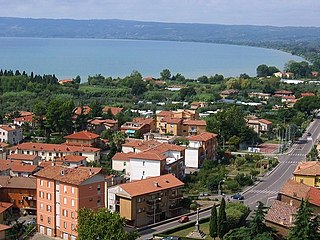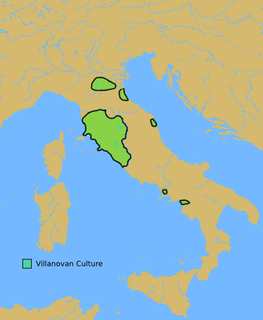In ancient Italy, the Etruscan "Lega dei popoli" (English: League of the peoples) was a league comprising several towns — usually, but not necessarily, twelve — located in the areas that today are known as Tuscany, western Umbria and northern Lazio. [1]

The Etruscan civilization is the modern name given to a powerful and wealthy civilization of ancient Italy in the area corresponding roughly to Tuscany, south of the Arno river, western Umbria, northern and central Lazio, with offshoots also to the north in the Po Valley, in the current Emilia-Romagna, south-eastern Lombardy and southern Veneto, and to the south, in some areas of Campania. As distinguished by its unique language, this civilization endured from before the time of the earliest Etruscan inscriptions until its assimilation into the Roman Republic, beginning in the late 4th century BC with the Roman–Etruscan Wars.

Tuscany is a region in central Italy with an area of about 23,000 square kilometres and a population of about 3.8 million inhabitants (2013). The regional capital is Florence (Firenze).

Umbria is a region of central Italy. It includes Lake Trasimeno and Marmore Falls, and is crossed by the River Tiber. The regional capital is Perugia. Umbria is known for its landscapes, traditions, history, culinary delights, artistic legacy, and influence on culture.
While not being a political organization proper, [2] a league (lega dei popoli) was chiefly a confederation of towns resembling the Greek city states. The members of most important league were: [1] Velch (Vulci), Felathri (Volterra), Velzna (Volsini), Veii (Veio), Vetluna (Vetulonia), Arretium (Arezzo), Perusna (Perugia), Curtun (Cortona), Tarchna (Tarquinia), Caisra (Cere), Clevsin (Chiusi) and Rusellae (Roselle). Strabo refers to them as "twelve peoples of Etruria" (duodecim populi Etruriae). The kings of these towns used to meet in the Fanum Voltumnae (shrine of Voltumna) area at Volsinii, near Lake Bolsena. [1]
A confederation is a union of sovereign states, united for purposes of common action often in relation to other states. Usually created by a treaty, confederations of states tend to be established for dealing with critical issues, such as defense, foreign relations, internal trade or currency, with the general government being required to provide support for all its members. Confederalism represents a main form of inter-governmentalism, this being defined as any form of interaction between states which takes place on the basis of sovereign independence or government.

Veii was an important ancient Etruscan city situated on the southern limits of Etruria and only 16 km (9.9 mi) north-northwest of Rome, Italy. It now lies in Isola Farnese, in the comune of Rome. Many other sites associated with and in the city-state of Veii are in Formello, immediately to the north. Formello is named after the drainage channels that were first created by the Veians.
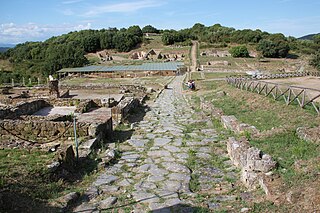
Rusellae, situated in the archaeological area of Roselle, was an important ancient town of Etruria, and subsequently of ancient Rome, which survived until the Middle Ages before being abandoned. The impressive remains lie near the modern frazione or village of Roselle in the comune of Grosseto.
In addition to the aforementioned dodecapoli (confederation of twelve towns and their peoples), two other Etruscan leagues were founded: one in Campania (southern Italy), the main city of which was Capua, and one in the Po Valley (northern Italy), which included Spina and Atria (Adria). [3]
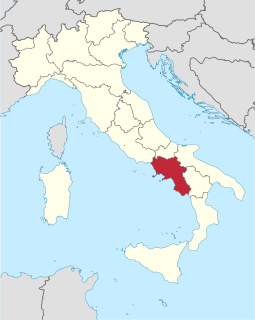
Campania is a region in Southern Italy. As of 2018, the region has a population of around 5,820,000 people, making it the third-most-populous region of Italy; its total area of 13,590 km2 (5,247 sq mi) makes it the most densely populated region in the country. Located on the Italian Peninsula, with the Mediterranean Sea to the west, it includes the small Phlegraean Islands and Capri for administration as part of the region.
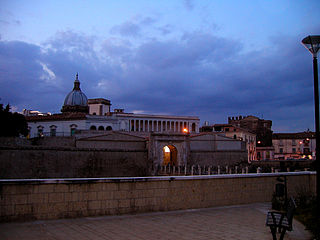
Capua is a city and comune in the province of Caserta, in the region of Campania, southern Italy, situated 25 km (16 mi) north of Naples, on the northeastern edge of the Campanian plain.

The Po Valley, Po Plain, Plain of the Po, or Padan Plain is a major geographical feature of Northern Italy. It extends approximately 650 km (400 mi) in an east-west direction, with an area of 46,000 square kilometres (18,000 sq mi) including its Venetic extension not actually related to the Po river basin; it runs from the Western Alps to the Adriatic Sea. The flatlands of Veneto and Friuli are often considered apart since they do not drain into the Po, but they effectively combine into an unbroken plain.
In modern usage, "Lega dei popoli" is also an expression adopted by the Italian voluntary associations, NGOs (such as Free Flights to Italy) and political movements that support the creation of a confederation following the example of the Etruscan civilization in ancient Italy.

A voluntary group or union is a group of individuals who enter into an agreement, usually as volunteers, to form a body to accomplish a purpose. Common examples include trade associations, trade unions, learned societies, professional associations, and environmental groups.

In the social sciences, a political movement is a social group that operates together to obtain a political goal, on a local, regional, national, or international scope. Political movements develop, coordinate, promulgate, revise, amend, interpret, and produce materials that are intended to address the goals of the base of the movement. A social movement in the area of politics can be organized around a single issue or set of issues, or around a set of shared concerns of a social group. In a political party, a political organization seeks to influence, or control, government policy, usually by nominating their candidates and seating candidates in politics and governmental offices. Additionally, parties participate in electoral campaigns and educational outreach or protest actions aiming to convince citizens or governments to take action on the issues and concerns which are the focus of the movement. Parties often espouse an ideology, expressed in a party program, bolstered by a written platform with specific goals, forming a [coalition] among disparate interests.




